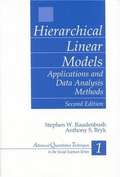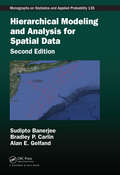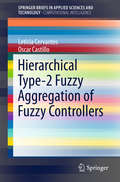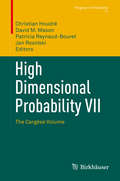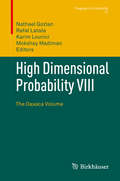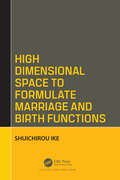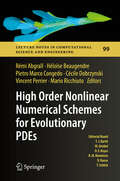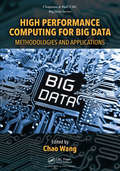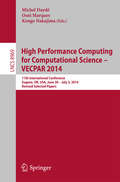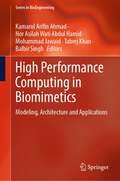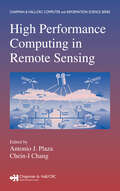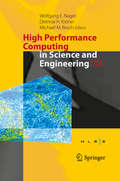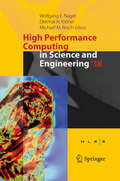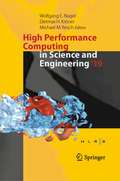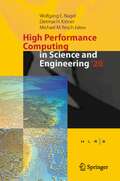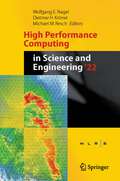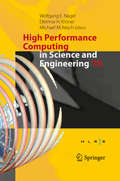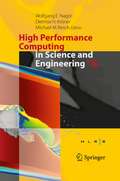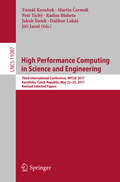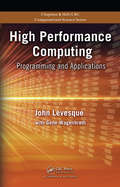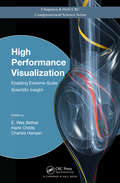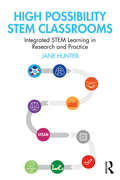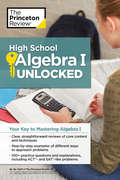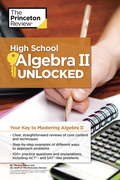- Table View
- List View
Hierarchical Linear Models: Applications and Data Analysis Methods (2nd Edition)
by Anthony S. Bryk Stephen W. RaudenbushThe first edition of this book was a bestseller. Now the author has added four more completely new chapters to this second edition.
Hierarchical Modeling and Analysis for Spatial Data (Chapman & Hall/CRC Monographs on Statistics and Applied Probability)
by Sudipto Banerjee Bradley P. Carlin Alan E. GelfandKeep Up to Date with the Evolving Landscape of Space and Space-Time Data Analysis and ModelingSince the publication of the first edition, the statistical landscape has substantially changed for analyzing space and space-time data. More than twice the size of its predecessor, Hierarchical Modeling and Analysis for Spatial Data, Second Edition reflec
Hierarchical Type-2 Fuzzy Aggregation of Fuzzy Controllers
by Oscar Castillo Leticia CervantesThisbook focuses on the fields of fuzzy logic, granular computing and alsoconsidering the control area. These areas can work together to solve variouscontrol problems, the idea is that this combination of areas would enable evenmore complex problem solving and better results. Inthis book we test the proposed method using two benchmark problems: the totalflight control and the problem of water level control for a 3 tank system. Whenfuzzy logic is used it make it easy to performed the simulations, these fuzzysystems help to model the behavior of a real systems, using the fuzzysystems fuzzy rules are generated and with this can generate the behavior ofany variable depending on the inputs and linguistic value. For this reason thiswork considers the proposed architecture using fuzzy systems and with thisimprove the behavior of the complex control problems.
High Dimensional Probability VII
by David M. Mason Christian Houdré Patricia Reynaud-Bouret Jan RosińskiThis volume collects selected papers from the 7th High Dimensional Probability meeting held at the Institut d'Études Scientifiques de Cargèse (IESC) in Corsica, France. High Dimensional Probability (HDP) is an area of mathematics that includes the study of probability distributions and limit theorems in infinite-dimensional spaces such as Hilbert spaces and Banach spaces. The most remarkable feature of this area is that it has resulted in the creation of powerful new tools and perspectives, whose range of application has led to interactions with other subfields of mathematics, statistics, and computer science. These include random matrix theory, nonparametric statistics, empirical process theory, statistical learning theory, concentration of measure phenomena, strong and weak approximations, functional estimation, combinatorial optimization, and random graph theory. The contributions in this volume show that HDP theory continues to thrive and develop new tools, methods, techniques and perspectives to analyze random phenomena.
High Dimensional Probability VIII: The Oaxaca Volume (Progress in Probability #74)
by Mokshay Madiman Nathael Gozlan Rafał Latała Karim LouniciThis volume collects selected papers from the 8th High Dimensional Probability meeting held at Casa Matemática Oaxaca (CMO), Mexico. High Dimensional Probability (HDP) is an area of mathematics that includes the study of probability distributions and limit theorems in infinite-dimensional spaces such as Hilbert spaces and Banach spaces. The most remarkable feature of this area is that it has resulted in the creation of powerful new tools and perspectives, whose range of application has led to interactions with other subfields of mathematics, statistics, and computer science. These include random matrices, nonparametric statistics, empirical processes, statistical learning theory, concentration of measure phenomena, strong and weak approximations, functional estimation, combinatorial optimization, random graphs, information theory and convex geometry. The contributions in this volume show that HDP theory continues to thrive and develop new tools, methods, techniques and perspectives to analyze random phenomena.
High Dimensional Space to Formulate Marriage and Birth Functions
by Shuichirou IkeWith the collapse of Demographic Transition Theory, new theories of population must not just be explanations, but should be falsifiable theories which can compute the number of occurrences of marriages and births. This book reviews computable marriage and birth function using dynamic properties. To do that, the functions are defined in high dimensional space. The reaction-diffusion equation of the number of children in a space is applied to these phenomena, providing solutions to many problems concerning a decline in fertility. The functions are developed as stochastic maps based on the present behaviors of successive behaviors in a geographical space. As we assume that there is an inter-dependence of human behaviors, we use the law of dynamics concerning the function of marriage and birth. The exact mathematical definition of interactions in a space naturally implies a causal relation. For the function concerning the number of children of parents, two geographical-dimensional spaces are required. The decline in fertility in Belgium due to different languages is explained, and the longer fertility period in Brittany is explained by the Laplacian of the diffusion equation. Depending on the degree of symbolic control over behaviors, we need to add the degree of the dimension of the space. For the marriage function, we add age as a biological dimension to the geographical space. In this higher dimensional space, the mapping from neighboring present marriages to neighboring successive marriages is no less than that of the marriage function. These chain reactions caused the baby boom as an exothermal reaction-diffusion. Birth functions require one to add the marriage-age dimension to two geographical and age dimensions so that it is a five dimensional hypersurface. It can, thus, determine birth probabilities of a female who married at a certain age. The phenomenon of modern fertility decline may only be the result of these chain reactions. These processes are solely dependent upon time-space, and not on socioeconomic conditions. This is the very reason why we are able to predict it mathematically. The book provides a new thinking in fertility decline for demographic research. Readers need to be aware that the fertility decline experienced throughout the modern era is a spatial pattern formation (as a reaction-diffusion). The author hopes new mathematical applications in human activities are developed through these new models.
High Order Nonlinear Numerical Schemes for Evolutionary PDEs
by Rémi Abgrall Héloïse Beaugendre Pietro Marco Congedo Cécile Dobrzynski Vincent Perrier Mario RicchiutoThis book collects papers presented during the European Workshop on High Order Nonlinear Numerical Methods for Evolutionary PDEs (HONOM 2013) that was held at INRIA Bordeaux Sud-Ouest, Talence, France in March, 2013. The central topic is high order methods for compressible fluid dynamics. In the workshop, and in this proceedings, greater emphasis is placed on the numerical than the theoretical aspects of this scientific field. The range of topics is broad, extending through algorithm design, accuracy, large scale computing, complex geometries, discontinuous Galerkin, finite element methods, Lagrangian hydrodynamics, finite difference methods and applications and uncertainty quantification. These techniques find practical applications in such fields as fluid mechanics, magnetohydrodynamics, nonlinear solid mechanics, and others for which genuinely nonlinear methods are needed.
High Performance Computing for Big Data: Methodologies and Applications (Chapman & Hall/CRC Big Data Series)
by Chao WangHigh-Performance Computing for Big Data: Methodologies and Applications explores emerging high-performance architectures for data-intensive applications, novel efficient analytical strategies to boost data processing, and cutting-edge applications in diverse fields, such as machine learning, life science, neural networks, and neuromorphic engineering. The book is organized into two main sections. The first section covers Big Data architectures, including cloud computing systems, and heterogeneous accelerators. It also covers emerging 3D IC design principles for memory architectures and devices. The second section of the book illustrates emerging and practical applications of Big Data across several domains, including bioinformatics, deep learning, and neuromorphic engineering. Features Covers a wide range of Big Data architectures, including distributed systems like Hadoop/Spark Includes accelerator-based approaches for big data applications such as GPU-based acceleration techniques, and hardware acceleration such as FPGA/CGRA/ASICs Presents emerging memory architectures and devices such as NVM, STT- RAM, 3D IC design principles Describes advanced algorithms for different big data application domains Illustrates novel analytics techniques for Big Data applications, scheduling, mapping, and partitioning methodologies Featuring contributions from leading experts, this book presents state-of-the-art research on the methodologies and applications of high-performance computing for big data applications. About the Editor Dr. Chao Wang is an Associate Professor in the School of Computer Science at the University of Science and Technology of China. He is the Associate Editor of ACM Transactions on Design Automations for Electronics Systems (TODAES), Applied Soft Computing, Microprocessors and Microsystems, IET Computers & Digital Techniques, and International Journal of Electronics. Dr. Chao Wang was the recipient of Youth Innovation Promotion Association, CAS, ACM China Rising Star Honorable Mention (2016), and best IP nomination of DATE 2015. He is now on the CCF Technical Committee on Computer Architecture, CCF Task Force on Formal Methods. He is a Senior Member of IEEE, Senior Member of CCF, and a Senior Member of ACM.
High Performance Computing for Computational Science -- VECPAR 2014
by Michel Daydé Osni Marques Kengo NakajimaThis book constitutes the thoroughly refereed post-conference proceedings of the 11th International Conference on High Performance Computing for Computational Science, VECPAR 2014, held in Eugene, OR, USA, in June/July 2014. The 25 papers presented were carefully reviewed and selected of numerous submissions. The papers are organized in topical sections on algorithms for GPU and manycores, large-scale applications, numerical algorithms, direct/hybrid methods for solving sparse matrices, performance tuning. The volume also contains the papers presented at the 9th International Workshop on Automatic Performance Tuning.
High Performance Computing in Biomimetics: Modeling, Architecture and Applications (Series in BioEngineering)
by Mohammad Jawaid Tabrej Khan Kamarul Arifin Ahmad Balbir Singh Nor Asilah Wati Abdul HamidThis book gives a complete overview of current developments in the implementation of high performance computing (HPC) in various biomimetic technologies. The book presents various topics that are subdivided into the following parts: A) biomimetic models and mechanics; B) locomotion and computational methods; C) distributed computing and its evolution; D) distributed and parallel computing architecture; E) high performance computing and biomimetics; F) big data, management, and visualization; and G) future of high performance computing in biomimetics. This book presents diverse computational technologies to model and replicate biologically inspired design for the purpose of solving complex human problems. The content of this book is presented in a simple and lucid style which can also be used by professionals, non-professionals, scientists, and students who are interested in the research area of high performance computing applications in the development of biomimetics technologies.
High Performance Computing in Remote Sensing
by Chein-I Chang Antonio J. PlazaSolutions for Time-Critical Remote Sensing ApplicationsThe recent use of latest-generation sensors in airborne and satellite platforms is producing a nearly continual stream of high-dimensional data, which, in turn, is creating new processing challenges. To address the computational requirements of time-critical applications, researchers
High Performance Computing in Science and Engineering ' 17
by Wolfgang E. Nagel Michael M. Resch Dietmar H. KrönerThis book presents the state-of-the-art in supercomputer simulation. It includes the latest findings from leading researchers using systems from the High Performance Computing Center Stuttgart (HLRS) in 2017. The reports cover all fields of computational science and engineering ranging from CFD to computational physics and from chemistry to computer science with a special emphasis on industrially relevant applications. Presenting findings of one of Europe’s leading systems, this volume covers a wide variety of applications that deliver a high level of sustained performance.The book covers the main methods in high-performance computing. Its outstanding results in achieving the best performance for production codes are of particular interest for both scientists and engineers. The book comes with a wealth of color illustrations and tables of results.
High Performance Computing in Science and Engineering ' 18: Transactions of the High Performance Computing Center, Stuttgart (HLRS) 2018
by Wolfgang E. Nagel Michael M. Resch Dietmar H. KrönerThis book presents the state-of-the-art in supercomputer simulation. It includes the latest findings from leading researchers using systems from the High Performance Computing Center Stuttgart (HLRS) in 2018. The reports cover all fields of computational science and engineering ranging from CFD to computational physics and from chemistry to computer science with a special emphasis on industrially relevant applications. Presenting findings of one of Europe’s leading systems, this volume covers a wide variety of applications that deliver a high level of sustained performance.The book covers the main methods in high-performance computing. Its outstanding results in achieving the best performance for production codes are of particular interest for both scientists and engineers. The book comes with a wealth of color illustrations and tables of results.
High Performance Computing in Science and Engineering '19: Transactions of the High Performance Computing Center, Stuttgart (HLRS) 2019
by Wolfgang E. Nagel Michael M. Resch Dietmar H. KrönerThis book presents the state-of-the-art in supercomputer simulation. It includes the latest findings from leading researchers using systems from the High Performance Computing Center Stuttgart (HLRS) in 2019. The reports cover all fields of computational science and engineering ranging from CFD to computational physics and from chemistry to computer science with a special emphasis on industrially relevant applications. Presenting findings of one of Europe’s leading systems, this volume covers a wide variety of applications that deliver a high level of sustained performance.The book covers the main methods in high-performance computing. Its outstanding results in achieving the best performance for production codes are of particular interest for both scientists and engineers. The book comes with a wealth of color illustrations and tables of results.
High Performance Computing in Science and Engineering '20: Transactions of the High Performance Computing Center, Stuttgart (HLRS) 2020
by Wolfgang E. Nagel Michael M. Resch Dietmar H. KrönerThis book presents the state-of-the-art in supercomputer simulation. It includes the latest findings from leading researchers using systems from the High Performance Computing Center Stuttgart (HLRS) in 2020. The reports cover all fields of computational science and engineering ranging from CFD to computational physics and from chemistry to computer science with a special emphasis on industrially relevant applications. Presenting findings of one of Europe’s leading systems, this volume covers a wide variety of applications that deliver a high level of sustained performance.The book covers the main methods in high-performance computing. Its outstanding results in achieving the best performance for production codes are of particular interest for both scientists and engineers. The book comes with a wealth of color illustrations and tables of results.
High Performance Computing in Science and Engineering '22: Transactions of the High Performance Computing Center, Stuttgart (HLRS) 2022
by Wolfgang E. Nagel Michael M. Resch Dietmar H. KrönerThis book presents the state-of-the-art in supercomputer simulation. It includes the latest findings from leading researchers using systems from the High Performance Computing Center Stuttgart (HLRS) in 2022. The reports cover all fields of computational science and engineering ranging from CFD to computational physics and from chemistry to computer science with a special emphasis on industrially relevant applications. Presenting findings of one of Europe’s leading systems, this volume covers a wide variety of applications that deliver a high level of sustained performance.The book covers the main methods in high-performance computing. Its outstanding results in achieving the best performance for production codes are of particular interest for both scientists and engineers. The book comes with a wealth of color illustrations and tables of results.
High Performance Computing in Science and Engineering ´15: Transactions of the High Performance Computing Center, Stuttgart (HLRS) 2015
by Wolfgang E. Nagel Michael M. Resch Dietmar H. KrönerThis book presents the state-of-the-art in supercomputer simulation. It includes the latest findings from leading researchers using systems from the High Performance Computing Center Stuttgart (HLRS) in 2015. The reports cover all fields of computational science and engineering ranging from CFD to computational physics and from chemistry to computer science with a special emphasis on industrially relevant applications. Presenting findings of one of Europe’s leading systems, this volume covers a wide variety of applications that deliver a high level of sustained performance. The book covers the main methods in high-performance computing. Its outstanding results in achieving the best performance for production codes are of particular interest for both scientists and engineers. The book comes with a wealth of color illustrations and tables of results.
High Performance Computing in Science and Engineering ´16: Transactions of the High Performance Computing Center, Stuttgart (HLRS) 2016
by Wolfgang E. Nagel Michael M. Resch Dietmar H. KrönerThis book presents the state-of-the-art in supercomputer simulation. It includes the latest findings from leading researchers using systems from the High Performance Computing Center Stuttgart (HLRS) in 2016. The reports cover all fields of computational science and engineering ranging from CFD to computational physics and from chemistry to computer science with a special emphasis on industrially relevant applications. Presenting findings of one of Europe’s leading systems, this volume covers a wide variety of applications that deliver a high level of sustained performance.The book covers the main methods in high-performance computing. Its outstanding results in achieving the best performance for production codes are of particular interest for both scientists and engineers. The book comes with a wealth of color illustrations and tables of results.
High Performance Computing in Science and Engineering ‘12
by Wolfgang E. Nagel Michael M. Resch Dietmar H. KrönerThis book presents the state-of-the-art in simulation on supercomputers. Leading researchers present results achieved on systems of the High Performance Computing Center Stuttgart (HLRS) for the year 2012. The reports cover all fields of computational science and engineering ranging from CFD via computational physics and chemistry to computer science with a special emphasis on industrially relevant applications. Presenting results for both vector-systems and micro-processor based systems the book allows to compare performance levels and usability of various architectures. As HLRS operates not only a large cluster system but also one of the largest NEC vector systems in the world this book gives an excellent insight also into the potential of vector systems. The book covers the main methods in high performance computing. Its outstanding results in achieving highest performance for production codes are of particular interest for both the scientist and the engineer. The book comes with a wealth of coloured illustrations and tables of results.
High Performance Computing in Science and Engineering: Third International Conference, HPCSE 2017, Karolinka, Czech Republic, May 22–25, 2017, Revised Selected Papers (Lecture Notes in Computer Science #11087)
by Tomáš Kozubek Radim Blaheta Jakub Šístek Martin Čermák Petr Tichý Dalibor Lukáš Jiří JarošThis book constitutes the thoroughly refereed post-conference proceedings of the Third International Conference on High Performance Computing in Science and Engineering, HPCSE 2017, held in Karolinka, Czech Republic, in May 2017.The 15 papers presented in this volume were carefully reviewed and selected from 20 submissions. The conference provides an international forum for exchanging ideas among researchers involved in scientific and parallel computing, including theory and applications, as well as applied and computational mathematics. The focus of HPCSE 2017 was on models, algorithms, and software tools which facilitate efficient and convenient utilization of modern parallel and distributed computing architectures, as well as on large-scale applications.
High Performance Computing: Programming and Applications (Chapman & Hall/CRC Computational Science)
by John Levesque Gene WagenbrethHigh Performance Computing: Programming and Applications presents techniques that address new performance issues in the programming of high performance computing (HPC) applications. Omitting tedious details, the book discusses hardware architecture concepts and programming techniques that are the most pertinent to application developers for achievi
High Performance Visualization: Enabling Extreme-Scale Scientific Insight (Chapman & Hall/CRC Computational Science)
by Hank Childs E. Wes Bethel Charles HansenVisualization and analysis tools, techniques, and algorithms have undergone a rapid evolution in recent decades to accommodate explosive growth in data size and complexity and to exploit emerging multi- and many-core computational platforms. High Performance Visualization: Enabling Extreme-Scale Scientific Insight focuses on the subset of scientifi
High Possibility STEM Classrooms: Integrated STEM Learning in Research and Practice
by Jane HunterThis book offers a new, research-based approach to STEM education in early, elementary, and middle years of schooling, concentrating on building teacher agency and integrated approaches to teaching and learning in High Possibility STEM Classrooms. Author Jane Hunter presents a globally oriented, contemporary framework for powerful Integrated STEM, based on mixed-methods research data from three studies conducted in 14 schools in language-diverse, disadvantaged, and urbanized communities in Australia. Theory, creativity, life preparation, public learning, and contextual accommodations are all utilized to help educators create hands-on, inquiry-led, and project-based approaches to STEM education in the classroom. A set of highly accessible case studies is offered that places pedagogy at the center of practice – an approach valuable for researchers, school leaders, and teachers alike. Ultimately, this text responds to the call for examples of what successful Integrated STEM teaching and learning looks like in schools. The book concludes with an evidence-based blueprint for preparing for less siloed and more transdisciplinary approaches to education in schools. Hunter argues not only for High Possibility STEM Classrooms but for High Possibility STEM Schools, enriching the dialogue around the future directions of STEM, STEAM, middle leadership, technological literacies, and assessment within contemporary classrooms.
High School Algebra I Unlocked: Your Key to Mastering Algebra I (High School Subject Review)
by Princeton ReviewThis eBook edition has been specially formatted for on-screen viewing with cross-linked questions, answers, and explanations.UNLOCK THE SECRETS OF ALGEBRA I with THE PRINCETON REVIEW.Algebra can be a daunting subject. That's why our new High School Unlocked series focuses on giving you a wide range of key techniques to help you tackle subjects like Algebra I. If one method doesn't "click" for you, you can use an alternative approach to understand the concept or problem, instead of painfully trying the same thing over and over without success. Trust us--unlocking the secrets of Algebra doesn't have to hurt!With this book, you'll discover the link between abstract concepts and their real-world applications and build confidence as your skills improve. Along the way, you'll get plenty of practice, from fully guided examples to independent end-of-chapter drills and test-like samples. Everything You Need to Know About Algebra I.* Complex concepts explained in clear, straightforward ways* Walk-throughs of sample problems for all topics* Clear goals and self-assessments to help you pinpoint areas for further review* Step-by-step examples of different ways to approach problems Practice Your Way to Excellence.* Drills and practice questions in every chapter* Complete answer explanations to boost understanding* ACT- and SAT-like questions for hands-on experience with how Algebra I may appear on major examsHigh School Algebra I Unlocked covers:* exponents and sequences* polynomial expressions* quadratic equations and inequalities* systems of equations* functions* units, conversions, and displaying data... and more!
High School Algebra II Unlocked
by Princeton ReviewThis eBook edition has been specially formatted for on-screen viewing with cross-linked questions, answers, and explanations.UNLOCK THE SECRETS OF ALGEBRA II with THE PRINCETON REVIEW.Algebra can be a daunting subject. That's why our new High School Unlocked series focuses on giving you a wide range of key techniques to help you tackle subjects like Algebra II. If one method doesn't "click" for you, you can use an alternative approach to understand the concept or problem, instead of painfully trying the same thing over and over without success. Trust us--unlocking the secrets of algebra doesn't have to hurt!With this book, you'll discover the link between abstract concepts and their real-world applications and build confidence as your skills improve. Along the way, you'll get plenty of practice, from fully guided examples to independent end-of-chapter drills and test-like samples. Everything You Need to Know About Algebra II.* Complex concepts explained in clear, straightforward ways* Walk-throughs of sample problems for all topics* Clear goals and self-assessments to help you pinpoint areas for further review* Step-by-step examples of different ways to approach problems Practice Your Way to Excellence.* Drills and practice questions in every chapter* Complete answer explanations to boost understanding* ACT- and SAT-like questions for hands-on experience with how Algebra II may appear on major examsHigh School Algebra II Unlocked covers:* complex numbers and polynomials* graphing and solving systems of equations* radical and rational expressions and inequalities* trigonometric equations* logarithmic functions and operations* statistical modeling... and more!
